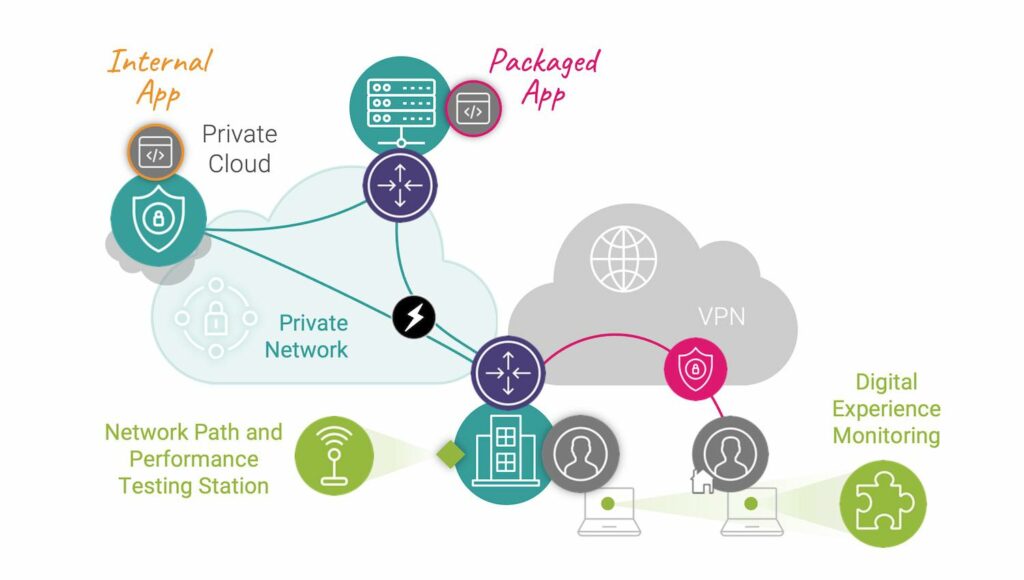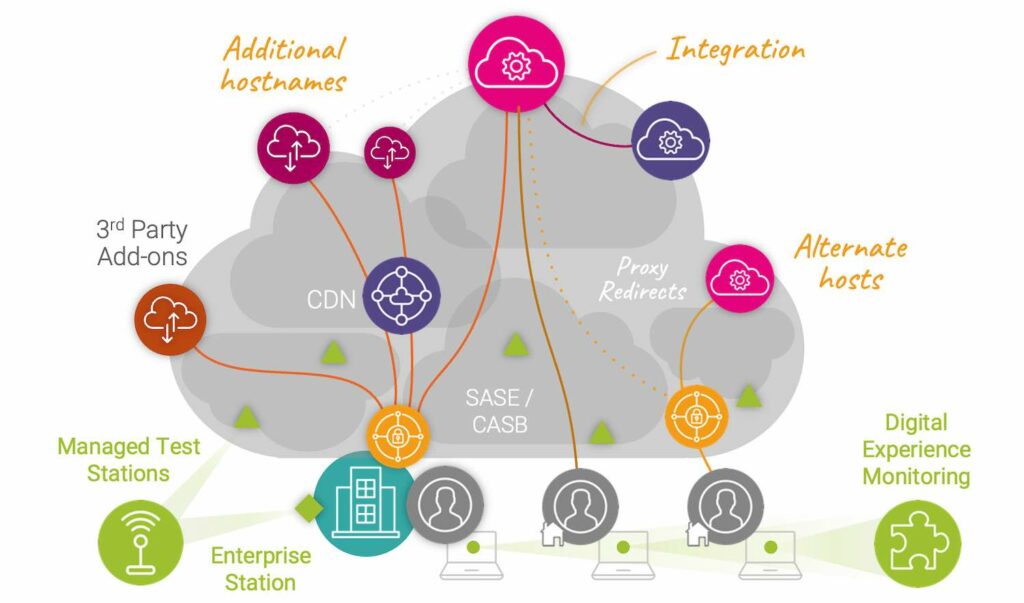Introducing SaaS requires a proactive, integrated performance management, SaaS user experience and cloud migration strategy to ensure the benefits of SaaS migration are realized and maximized over time.
Application Migration to Cloud: SaaS Experience Challenges
Cloud migration and SaaS migration face similar challenges: moving from dedicated, private networks and hosting infrastructure to public networks and third-party hosted applications that are difficult for IT operations teams to optimize and control. The resulting SaaS experience will largely depend on a broad SaaS digital transformation effort that must optimize all elements along the service delivery chain between end-user and SaaS application, many introduced as part of a larger cloud migration strategy.
What Impacts SaaS Experience and SaaS Application Performance?
- The modern security edge: SASE / CASB solutions introduced to secure access to cloud and SaaS applications can introduce significant latency from proxy processing and traffic redirection.
- Distributed users and dynamic networks: the rise of work from home and hybrid working make it difficult to identify the impact of network connectivity across ISP / internet, SD WAN, VPN and hybrid networks and SaaS-providers’ CDNs on SaaS experience and application performance.
- SaaS host locations: Not all SaaS cloud applications are hosted in all regions. Users in Europe will have a poor SaaS experience if application hosts are located in North America, for example.
- Browser and transactional performance: SaaS application digital experience can’t be accurately assessed using simple page load performance metrics. As single page applications (SPA), SaaS experience is largely defined by script execution and browser-host transactions: errors, host response and processing performance.
- Lack of SaaS-centric performance visibility: legacy network performance monitoring (NPM) and application performance monitoring (APM) tools are unable to instrument, capture and analyze encrypted SaaS application traffic across the large number of distributed hosts that serve them.
Reap the Benefits of SaaS Migration With a Proven Cloud Migration Strategy
Just as moving private, internal applications to the cloud requires a multi-step cloud migration strategy to ensure success, so does adoption of cloud-based SaaS applications. Just like cloud migration, SaaS adoption starts with knowing where you stand, then keeping a close eye on performance as you pilot and scale out your SaaS adoption to all employees.
Baseline Digital Experience of Existing Applications
Predict user expectations by monitoring how they experience the applications SaaS migration will replace. Measure response time and latency across all regions and employee locations. Troubleshoot any infrastructure bottlenecks that will will support your SaaS digital transformation (e.g. MPLS / VPN connectivity performance, transaction performance to packaged and internal applications that integrate with your SaaS applications) – the last thing you need during a SaaS migration is to bring old ghosts along to haunt it!
Pilot SaaS Applications to Identify Performance Bottlenecks
- Actively test network path performance from all business regions to identify SaaS performance issues caused by suboptimal geo-based DNS redirects, CASB proxy latency, SD WAN traffic prioritization, ISP / internet underlay performance and BGP routing policies, or non-uniform CDN coverage.
- Monitor SaaS experience from the users’ context: onsite, work from home and mobile employees using the SaaS application across a broad range of use cases to uncover scenarios that degrade user digital experience and productivity.
- Verify the performance of SaaS integration with application extensions, integrated 3rd-Party and private applications, cloud-hosted services and PaaS-based components. As each can be served by a wide range of hostnames and may be connected by cloud networks, it’s important to assess their performance impact on the overall SaaS experience.
Scale SaaS Adoption with Real-Time Visibility
Optimize SaaS application performance at scale by identifying sources of degradations affecting the SaaS experience and resolving issues originating from devices, browsers, network connectivity and SaaS hosting as they emerge. Use evidence from network and application performance monitoring to ensure SLAs with vendors are enforced and that they quickly fix issues within their infrastructure.
Embrace Continuous SaaS Performance Management
Continually and proactively optimize SaaS performance to ensure maximum benefits of SaaS migration. SaaS and integrated application updates, SD WAN, cloud and ISP network performance, user location and behavior are all highly dynamic and can result in SaaS experience degradations that can have a significant business impact. Maintaining peak performance after SaaS migration ensures optimal user experience and productivity that delivers a competitive digital advantage.
Performance Management: SaaS Application Monitoring Benefits
Seeing clearly into existing and modern SaaS digital infrastructure is essential to cloud SaaS migration. Having visibility into the SaaS experience and the underlying network, application and user performance delivers multiple benefits to IT and network operations teams, the business and its customers:
- Reduce risk and business disruption with the ability to detect SaaS performance degradation, rapidly isolate and resolve them
- Accelerate SaaS migration: stay within budget and on schedule by eliminating blindspots and reducing surprises
- Maximize benefits of SaaS migration: enhanced SaaS experience, user productivity and efficient digital platform integration
- Exceed user expectations and optimize performance across all regions, sites and work from home employees
- Hold vendors accountable with clear data-driven insights and fault isolation capabilities
You can learn the best methods to monitor SaaS performance in this related article.
Ensure a Successful SaaS Experience
Delivering an amazing SaaS user experience and meeting SaaS migration goals is assured by a SaaS adoption strategy that relies on consistent full-stack performance visibility to benchmark your starting position, assesses infrastructure readiness, monitor and optimize SaaS experience during pilot and full deployment phases. Once SaaS migration is complete, continuous monitoring and proactive optimization ensure the benefits of SaaS migration are fully realized and deliver enhanced business performance.
Learn More
The Kadiska digital experience platform was designed to monitor SaaS applications and facilitate SaaS adoption by addressing the visibility gap facing IT and network operations. We cover how to address the key challenges SaaS introduces and provide a live demo of troubleshooting SaaS experience issues in our SaaS Performance Monitoring – Best Practices webinar.










